Abstract
Seven isolates of Yersinia enterocolitica serotype 0:8, recovered during an outbreak of gastrointestinal illness, were examined for enterotoxin production. All seven strains were enterotoxigenic in the suckling mouse model, and three of five isolates tested produced keratoconjunctivitis in the guinea pig eye model (Sereny test). Enterotoxin was detected in broth supernatant fluid after 12 h of incubation at 25 degrees C. The toxin was not inactivated by exposure to 121 degrees C for 30 min or by storage at 4 or -40 degrees C for at least 5 months. The enterotoxin was also acid stable and methanol soluble. Methanol extraction did not affect its heat stability or enterotoxic activity in suckling mice. These physical characteristics plus limited ultrafiltration studies suggest that the enterotoxin is a low-molecular-weight substance. Y. enterocolitica enterotoxin resembles Escherichia coli heat-stable enterotoxin in heat and pH stability, methanol solubility, and enterotoxic activity in suckling mice. However, its role in the pathogenesis of human diarrhea has not been established.
Full text
PDF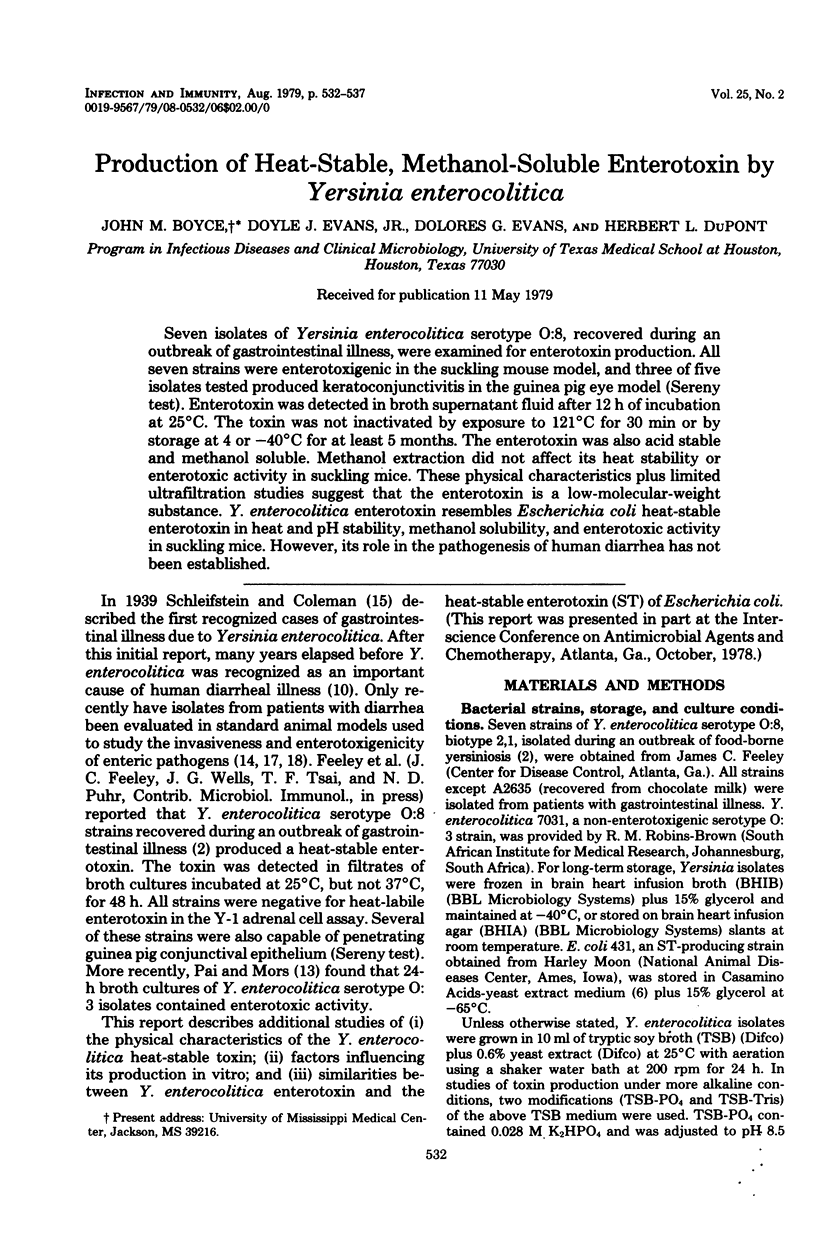
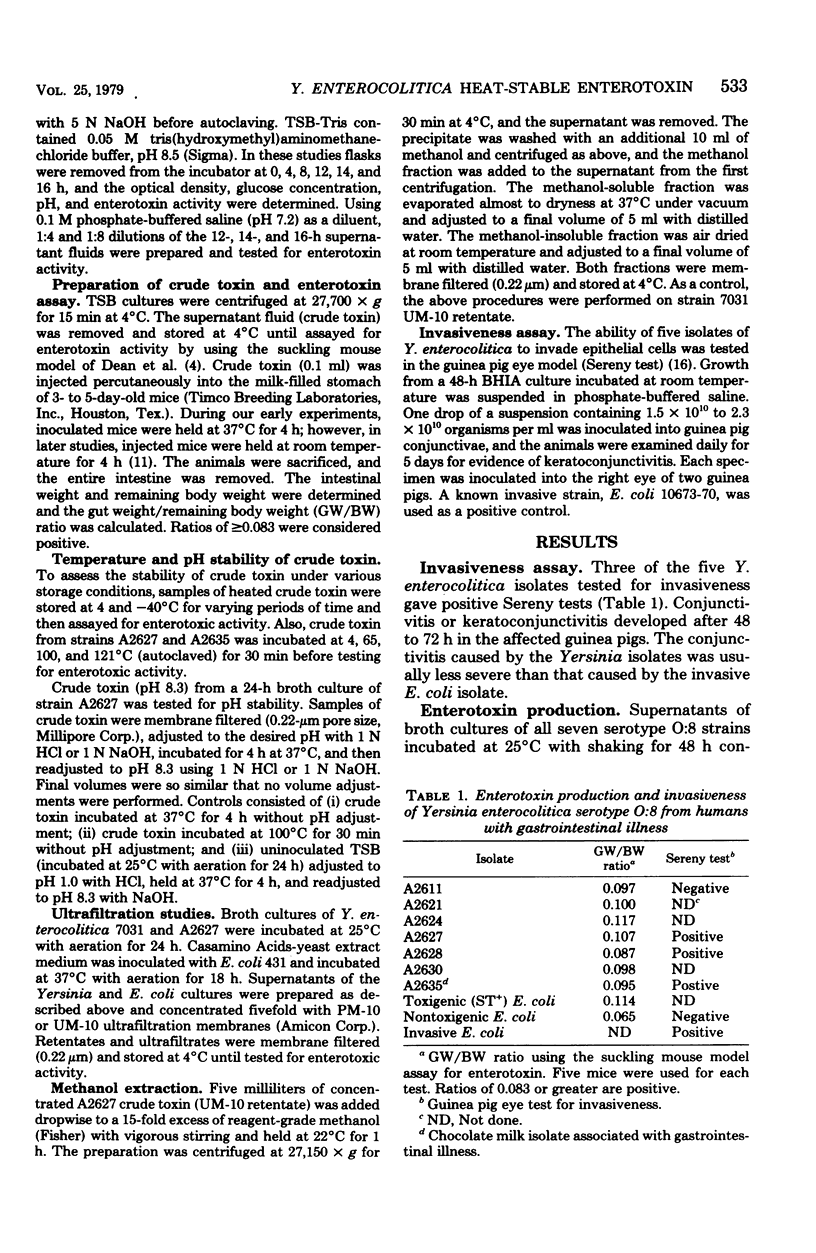
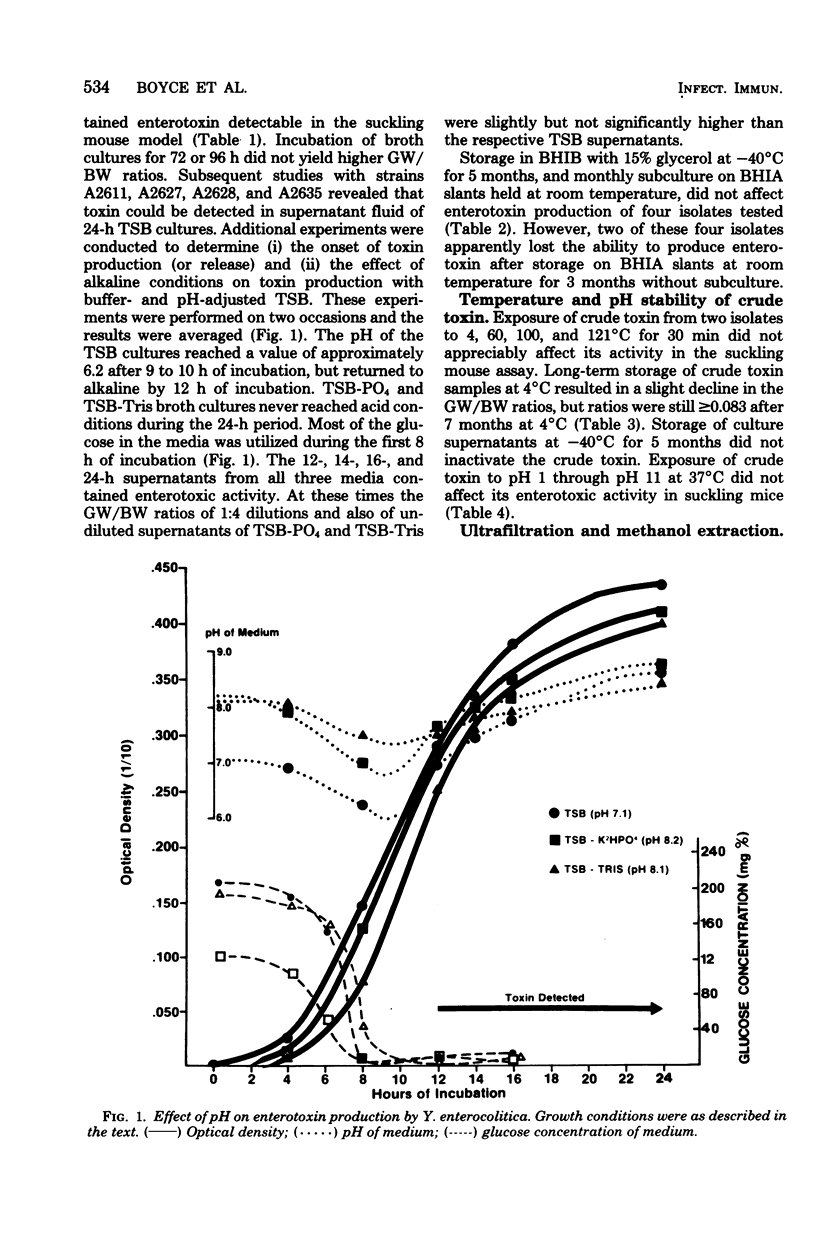
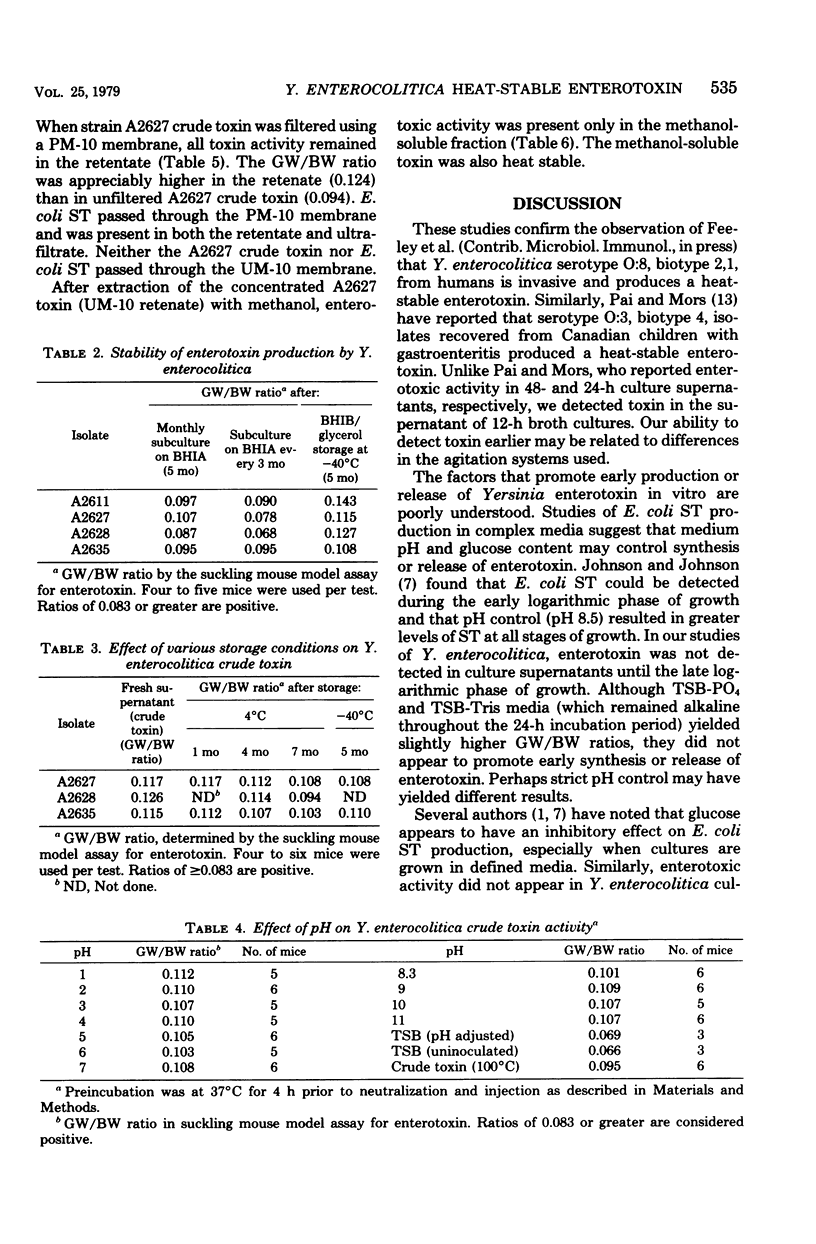
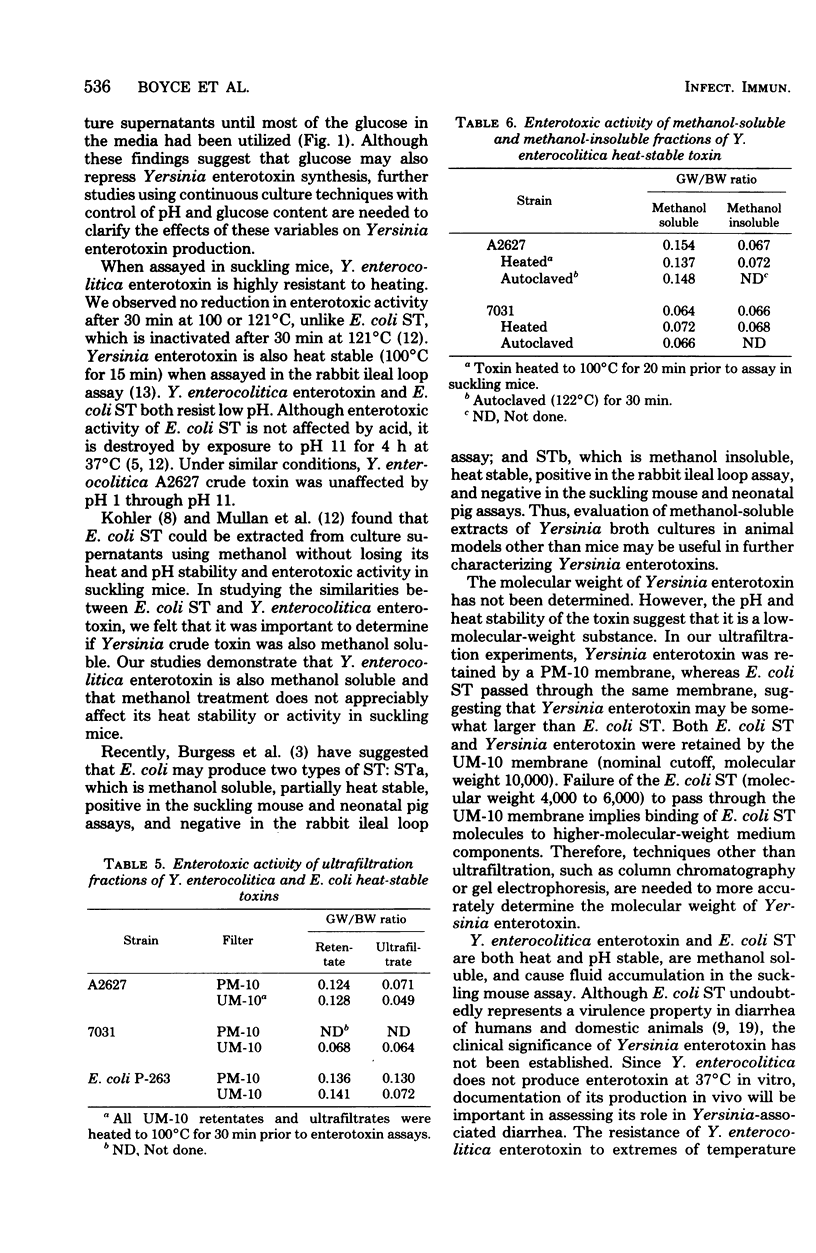
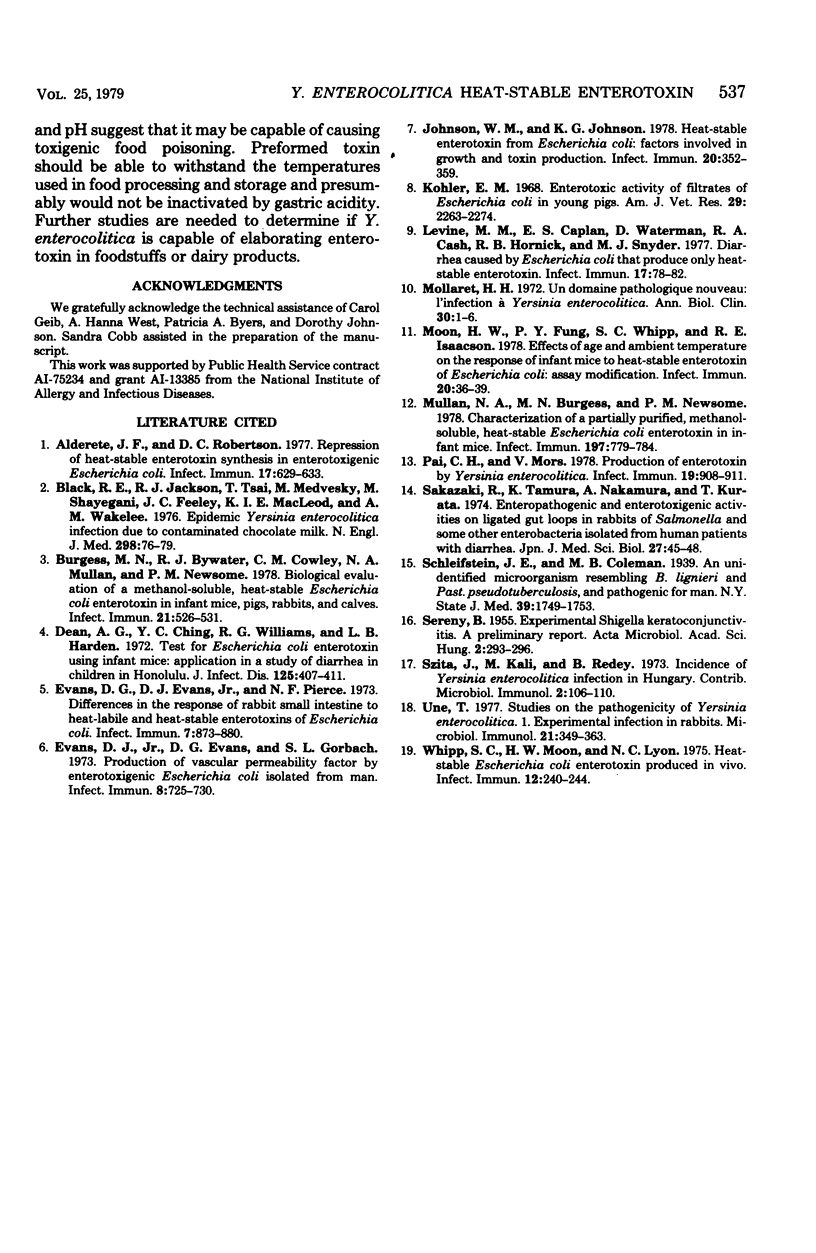
Selected References
These references are in PubMed. This may not be the complete list of references from this article.
- Alderete J. F., Robertson D. C. Repression of heat-stable enterotoxin synthesis in enterotoxigenic Escherichia coli. Infect Immun. 1977 Sep;17(3):629–633. doi: 10.1128/iai.17.3.629-633.1977. [DOI] [PMC free article] [PubMed] [Google Scholar]
- Black R. E., Jackson R. J., Tsai T., Medvesky M., Shayegani M., Feeley J. C., MacLeod K. I., Wakelee A. M. Epidemic Yersinia enterocolitica infection due to contaminated chocolate milk. N Engl J Med. 1978 Jan 12;298(2):76–79. doi: 10.1056/NEJM197801122980204. [DOI] [PubMed] [Google Scholar]
- Burgess M. N., Bywater R. J., Cowley C. M., Mullan N. A., Newsome P. M. Biological evaluation of a methanol-soluble, heat-stable Escherichia coli enterotoxin in infant mice, pigs, rabbits, and calves. Infect Immun. 1978 Aug;21(2):526–531. doi: 10.1128/iai.21.2.526-531.1978. [DOI] [PMC free article] [PubMed] [Google Scholar]
- Dean A. G., Ching Y. C., Williams R. G., Harden L. B. Test for Escherichia coli enterotoxin using infant mice: application in a study of diarrhea in children in Honolulu. J Infect Dis. 1972 Apr;125(4):407–411. doi: 10.1093/infdis/125.4.407. [DOI] [PubMed] [Google Scholar]
- Evans D. G., Evans D. J., Jr, Pierce N. F. Differences in the response of rabbit small intestine to heat-labile and heat-stable enterotoxins of Escherichia coli. Infect Immun. 1973 Jun;7(6):873–880. doi: 10.1128/iai.7.6.873-880.1973. [DOI] [PMC free article] [PubMed] [Google Scholar]
- Evans D. J., Jr, Evans D. G., Gorbach S. L. Production of vascular permeability factor by enterotoxigenic Escherichia coli isolated from man. Infect Immun. 1973 Nov;8(5):725–730. doi: 10.1128/iai.8.5.725-730.1973. [DOI] [PMC free article] [PubMed] [Google Scholar]
- Johnson W. M., Lior H., Johnson K. G. Heat-stable enterotoxin from Escherichia coli: factors involved in growth and toxin production. Infect Immun. 1978 May;20(2):352–359. doi: 10.1128/iai.20.2.352-359.1978. [DOI] [PMC free article] [PubMed] [Google Scholar]
- Kohler E. M. Enterotoxic activity of filtrates of escherichia coli in young pigs. Am J Vet Res. 1968 Dec;29(12):2263–2274. [PubMed] [Google Scholar]
- Levine M. M., Caplan E. S., Waterman D., Cash R. A., Hornick R. B., Snyder M. J. Diarrhea caused by Escherichia coli that produce only heat-stable enterotoxin. Infect Immun. 1977 Jul;17(1):78–82. doi: 10.1128/iai.17.1.78-82.1977. [DOI] [PMC free article] [PubMed] [Google Scholar]
- Moon H. W., Fung P. Y., Whipp S. C., Isaacson R. E. Effects of age and ambient temperature on the responses of infant mice to heat-stable enterotoxin of Escherichia coli: assay modifications. Infect Immun. 1978 Apr;20(1):36–39. doi: 10.1128/iai.20.1.36-39.1978. [DOI] [PMC free article] [PubMed] [Google Scholar]
- Mullan N. A., Burgess M. N., Newsome P. M. Characterization of a partially purified methanol-soluble heat-stable Escherichia coli enterotoxin in infant mice. Infect Immun. 1978 Mar;19(3):779–784. doi: 10.1128/iai.19.3.779-784.1978. [DOI] [PMC free article] [PubMed] [Google Scholar]
- Pai C. H., Mors V. Production of enterotoxin by Yersinia enterocolitica. Infect Immun. 1978 Mar;19(3):908–911. doi: 10.1128/iai.19.3.908-911.1978. [DOI] [PMC free article] [PubMed] [Google Scholar]
- SERENY B. Experimental shigella keratoconjunctivitis; a preliminary report. Acta Microbiol Acad Sci Hung. 1955;2(3):293–296. [PubMed] [Google Scholar]
- Une T. Studies on the pathogenicity of Yersinia enterocolitica. I. Experimental infection in rabbits. Microbiol Immunol. 1977;21(7):341–363. [PubMed] [Google Scholar]
- Whipp S. C., Moon H. W., Lyon N. C. Heat-stable Escherichia coli enterotoxin production in vivo. Infect Immun. 1975 Aug;12(2):240–244. doi: 10.1128/iai.12.2.240-244.1975. [DOI] [PMC free article] [PubMed] [Google Scholar]


